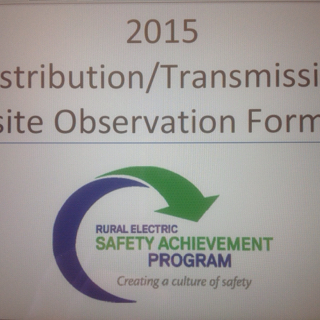Title Page
-
Cooperative Name
-
Location
-
- Main Facility
- Outpost
-
Conducted on
-
Prepared by
Co-ops next on-site observation
-
2018
-
2019
-
2020
-
2021
-
2022
Section 14: Arc Related Clothing/ Systems + Fall Protection
-
14.1 System has performed an arch hazard assessment for arc rated clothing needs and supervisors can explain which positions are affected. <br><br>ref: NESC Rule 410.A.3
-
14.2 Arch rated shirts are worn by affected employees.
-
14.3 Arc rated pants are worn by affected employees.
-
14.4 Arc rated rainwear is available for affected employees.
-
14.5 Arc rated outerwear is available for affected employees.
-
14.6 Arc rated winter liners are available for affected employees.
-
14.7 Arc related traffic control vests are available for affected employees.
-
14.8 Interviewed employees are knowledgeable about the purpose and their local requirements for arc rated clothing.
-
14.9 Fall protection equipment meets applicable OSHA/ANSI standards and specifications for jobs being performed. <br>Criteria:<br>* Equipment is properly sized and fitted to the individual.<br>* Equipment is free of any modifications and found in very good condition.<br>* Labels shall be maintained on equipment and should be legible. All fall protection equipment should be inspected at least every 6 months after initial service by a competent person. Only full body harnesses shall be used for fall arrest. <br>* Harnesses and lanyards shall be stored appropriately (in a bin, which is dry and clean, and apart from any materials that cold cause damage). (To receive an "Exceeds" evaluation, this equipment is stored in fall protection equipment storage bags.)<br>* The fall arrest attachment point of the body harness shall be at the center of the user's back near shoulder level and with a proper lanyard that will limit employee falls to a maximum of six (6) feet, nor contact any lower level. <br><br>ref: ANSI Z359.1-2007 or later
-
14.10 Attachment points for fall protection on equipment or structures are designed for the potential shock loading.
-
14.11 Fall protection equipment is properly stored where its serviceable condition can be best maintained. <br>Criteria:<br>* Storage area provided on each truck for all protection equipment or properly stored in equipment bags.<br>* Fall protection equipment is stored clear of any items that can damage these items. <br><br>ref: 1926.1423(d); 29 CFR 1910.132
-
14.12 Body belts, straps, and climbers meet OSHA/ANSI standards for fall positioning/fall protection equipment ad the following specifications for sizing, use, and storage.<br>Criteria:<br>* Climbing equipment with 100% fall protection is assigned and fitted to each climber and work positioning systems shall be rigged so an employee can fall no more than 0.6 meters (2 feet).<br>* Space is available on utility trucks for stowing climbing tools with 100% fall protection or these tools are properly stored in protective individual tool bags. <br>* Stowed climbers have appropriate gaff guards in place.<br>* Climbing tools with 100% fall protection, or bags containing these items are stored clear of objects that would damage this equipment. <br><br>ref: ANSI Z359.1-2007 or later
Section 14: Summary
-
14.13 The overall evaluation of the onsite field observation team for this section of the assessment is as follows:<br>Criteria: <br>* Strong performance - Questions evaluated as exceeds or satisfies all requirements.<br>* Satisfactory performance - Questions evaluated as satisfies all requirements, could be a small number evaluated as exceeds.<br>* Generally satisfactory with minor areas for improvement - Questions evaluated as satisfies all or most requirements, improvement areas are minor<br>* Key attention areas for improvement - Questions evaluated as partially satisfies or fails to satisfy requirements in important improvement areas<br>
CREA Safety Personnel Signature
-
Dale Kishbaugh
-
Dan Whitesides
-
Curt Graham
-
Angelea Meyer














